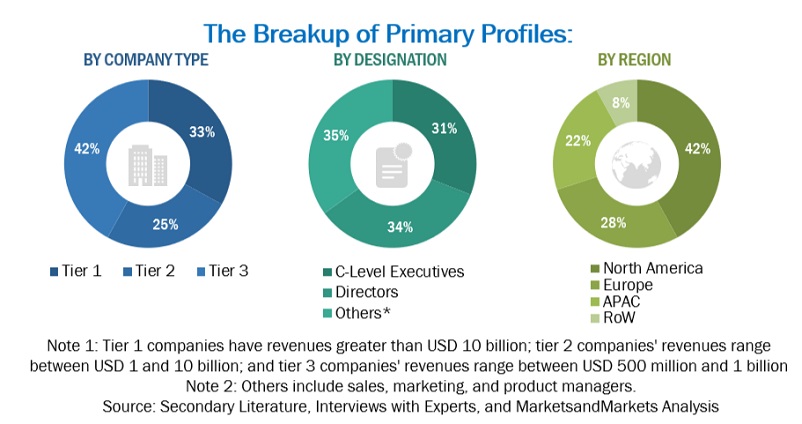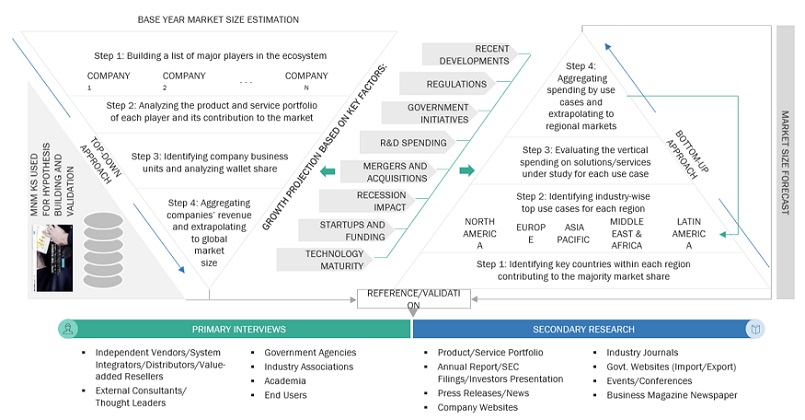The study comprised four main activities to estimate the size of the video on demand market. We conducted significant secondary research to gather data on the market, the competing market, and the parent market. The following stage involved conducting primary research to confirm these conclusions and hypotheses and sizing with industry experts throughout the value chain. The overall market size was evaluated using a blend of top-down and bottom-up approach methodologies. After that, we estimated the market sizes of the various video on demand market segments using the market breakup and data triangulation techniques.
Secondary Research
Multiple secondary sources were consulted throughout the secondary research process to identify and gather information for this study. These included annual reports, white papers, certified publications, press releases, investor presentations of companies, and articles from recognized associations and government publishing sources. Other sources include journals such as the Information Technology and Security (IJCSITS) and The Journal of Network and Computer Applications and associations such as the International Journal of Computer Science, Journal of Information Security and Applications, and the Technology Services Industry Association (TSIA) and The World Information Technology and Services Alliance (WITSA).
Secondary research was mainly used to obtain critical information about the industry insights, the market’s monetary chain, the extensive collection of key stakeholders, market segmentation, industry trend-based categorization down to the regional level, and notable developments in market and technology.
Primary Research
In the initial research stage, we interviewed multiple primary resources from both the supply and demand sides of the video on demand market to collect qualitative and quantitative data to enhance the study. The primary sources from the supply side included industry experts, such as technology and innovation directors, Chief Executive Officers (CEOs), marketing directors, Vice Presidents (VPs), related vital executives from vendors providing VoD offerings, associated service providers, and SIs operating in the targeted countries. All possible parameters that affect the market covered in this research study have been accounted for, viewed in extensive detail, verified through primary research, and analyzed to arrive at the final quantitative and qualitative data.
After the complete market engineering process (including calculations for market statistics, market breakup, market size estimations, market forecasting, and data triangulation), extensive primary research was conducted to gather information and verify and validate the critical numbers arrived at. The primary research also helped identify and validate the segmentation, industry trends, key players, competitive landscape, and market dynamics, such as drivers, restraints, opportunities, challenges, and key strategies. In the complete market engineering process, the bottom-up approach and several data triangulation methods were extensively used to perform market estimation and market forecasting for the overall market segments and subsegments listed in this report. An extensive qualitative and quantitative analysis of the complete market engineering process was performed to document the key information/insights throughout the report.

To know about the assumptions considered for the study, download the pdf brochure
Video on Demand Market Size Estimation
The video on demand market and related submarkets were estimated and forecasted using top-down and bottom-up methodologies. Using the revenues and product offerings of the major market players, the bottom-up method was used to determine the size of the market overall. This research ascertained and validated the precise value of the total parent market size through data triangulation techniques and primary interview validation. Next, using percentage splits of the market segments, the overall market size was utilized in the top-down approach to estimate the size of other individual markets.
Top Down and Bottom Up Approach of Video on Demand Market.

To know about the assumptions considered for the study, Request for Free Sample Report
The research methodology used to estimate the market size included the following:
-
Primary and secondary research was utilized to determine the revenue contributions of the major market participants in each country after secondary research helped identify them.
-
Throughout the process, critical insights were obtained by conducting in-depth interviews with industry professionals, including directors, CEOs, VPs, and marketing executives, and by reading the annual and financial reports of the top firms in the market.
-
Primary sources were used to verify all percentage splits and breakups, which were calculated using secondary sources.
Data Triangulation
The market was divided into several segments and subsegments using the previously described market size estimation procedures once the overall market size was determined. When required, market breakdown and data triangulation procedures were employed to complete the market engineering process and specify the exact figures for every market segment and subsegment. The data was triangulated by examining several variables and patterns from government entities' supply and demand sides.
Video on Demand Market Definition
MarketsandMarkets defines Video on Demand as the infrastructure and systems to deliver video content to end-users online. This typically involves streaming technology, content delivery networks (CDNs), digital rights management (DRM), and other components to ensure reliable and secure delivery of video content. VoD systems utilize streaming protocols to deliver video content to users in real-time or near-real-time. These protocols, such as Dynamic Adaptive Streaming over HTTP (DASH), HTTP Live Streaming (HLS), or MPEG-DASH, facilitate the transmission of video data in a format that can be decoded and played back by the user's device as it is received. VoD systems may implement user authentication mechanisms to verify the identity of users and grant appropriate access permissions to content. This can involve user accounts, passwords, access tokens, or other authentication methods to control who can view specific videos and under what conditions.
Key Stakeholders
-
VoD Services Providers (VSPs)
-
VoD platform providers
-
Technology services providers
-
Government organizations
-
Consultants/consultancies/advisory firms
-
Support and maintenance services providers
-
Information Technology (IT) infrastructure providers
-
System Integrators (SIs)
-
Regional associations
-
Independent software vendors
-
Value-added resellers and distributors
Report Objectives
-
To define, describe, and forecast the global VoD market based on offering type, monetization model, deployment model, platform type, content type, vertical, and region
-
To provide detailed information about the major factors (drivers, opportunities, restraints, and challenges) influencing the growth of the VoD market
-
To analyze the opportunities in the market for stakeholders by identifying the high-growth segments of the VoD market
-
To forecast the market size concerning five central regions - North America, Europe, Asia Pacific, the Middle East, Africa, and Latin America
-
To analyze the subsegments of the market concerning individual growth trends, prospects, and contributions to the overall market
-
To profile the key players of the VoD market and comprehensively analyze their market size and core competencies
-
To track and analyze the competitive developments, such as product enhancements and product launches, acquisitions, and partnerships and collaborations, in the VoD market globally
Available Customizations
MarketsandMarkets provides customizations based on the company's unique requirements using market data. The following customization options are available for the report:
Product Analysis
-
The product matrix provides a detailed comparison of the product portfolio of each company.
Geographic Analysis
-
Further breakup of the VoD market
Company Information
-
Detailed analysis and profiling of five additional market players



Growth opportunities and latent adjacency in Video on Demand (VoD) Market